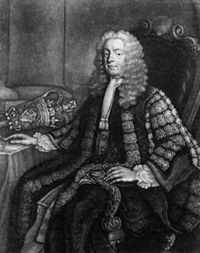
Henry Boyle, 1st Earl of Shannon
Encyclopedia

Privy Council of Ireland
The Privy Council of Ireland was an institution of the Kingdom of Ireland until 31 December 1800 and of the United Kingdom of Great Britain and Ireland 1801-1922...
(1682 – 28 December 1764) was a prominent Irish
Ireland
Ireland is an island to the northwest of continental Europe. It is the third-largest island in Europe and the twentieth-largest island on Earth...
politician.
Boyle was the second son of Lieutenant-Colonel Henry Boyle (1648-1693), second son of Roger Boyle, 1st Earl of Orrery
Roger Boyle, 1st Earl of Orrery
Roger Boyle redirects here. For others of this name, see Roger Boyle Roger Boyle, 1st Earl of Orrery was a British soldier, statesman and dramatist. He was the third surviving son of Richard Boyle, 1st Earl of Cork and Richard's second wife, Catherine Fenton. He was created Baron of Broghill on...
. His mother was Lady Mary O'Brien, daughter of Murrough O'Brien, 1st Earl of Inchiquin
Murrough O'Brien, 1st Earl of Inchiquin
Murrough McDermod O'Brien, 1st Earl of Inchiquin and 6th Baron Inchiquin , was known as Murchadh na dTóiteán ....
. In, 1707, he was elected to the Irish House of Commons
Irish House of Commons
The Irish House of Commons was the lower house of the Parliament of Ireland, that existed from 1297 until 1800. The upper house was the House of Lords...
for Midleton
Midleton (Parliament of Ireland constituency)
Midleton was a constituency represented in the Irish House of Commons until 1800. Incorporated by Charter, 1671 whereby it was granted to Sir John Brodrick with a Corporation sovereign, two bailiffs and 12 burgesses. It was disenfranchised at the Act of Union and compensation of £15,000 paid to...
, a seat he held until 1713, and then sat for Kilmallock
Kilmallock (Parliament of Ireland constituency)
Kilmallock was a constituency represented in the Irish House of Commons until 1800.-History:In the Patriot Parliament of 1689 summoned by King James II, Kilmallock was represented with two members.-1689–1801:...
from 1713 to 1715. Between 1715 and 1756 he represented County Cork. He quickly gained a prominent role in Parliament and Sir Robert Walpole is said to have styled him "the King of the Irish House of Commons". In 1733 Boyle was admitted to the Irish House of Commons
Irish House of Commons
The Irish House of Commons was the lower house of the Parliament of Ireland, that existed from 1297 until 1800. The upper house was the House of Lords...
and appointed Chancellor of the Irish Exchequer. Later that year he was also made Speaker of the Irish House of Commons.
He held these posts until 1753, when he was dismissed by the viceroy Lord Dorset
Lionel Sackville, 1st Duke of Dorset
Lionel Cranfield Sackville, 1st Duke of Dorset, PC was an English political leader and Lord Lieutenant of Ireland. He was the son of the 6th Earl of Dorset and 1st Earl of Middlesex and the former Lady Mary Compton, younger daughter of the 3rd Earl of Northampton...
for refusing to pay over an Irish tax surplus to the government in London. This led to the "Money Bill dispute" of 1753-56, and Boyle came to be seen as an early Irish patriot
Irish Patriot Party
The Irish Patriot Party was the name of a number of different political groupings in Ireland throughout the 18th century. They were primarily supportive of Whig concepts of personal liberty combined with an Irish identity that rejected full independence, but advocated strong self-government within...
. Reinstated in 1755 by Devonshire
William Cavendish, 4th Duke of Devonshire
William Cavendish, 4th Duke of Devonshire, KG, PC , styled Lord Cavendish before 1729 and Marquess of Hartington between 1729 and 1755, was a British Whig statesman who was briefly nominal Prime Minister of Great Britain...
, the next viceroy, in 1756 he was raised to the Peerage of Ireland
Peerage of Ireland
The Peerage of Ireland is the term used for those titles of nobility created by the English and later British monarchs of Ireland in their capacity as Lord or King of Ireland. The creation of such titles came to an end in the 19th century. The ranks of the Irish peerage are Duke, Marquess, Earl,...
as Baron Castle Martyr, Viscount Boyle, of Bandon, and Earl of Shannon. He also acted several times as Lord Chief Justice of Ireland
Lord Chief Justice of Ireland
thumb|200px|The Four CourtsThe headquarters of the Irish judicial system since 1804. The Court of King's Bench was one of the original four courts that sat there....
.
Lord Shannon married, firstly, Catherine, daughter of Chidley Coote, in 1715. After her death in 1725 he married, secondly, Lady Henrietta Boyle, youngest daughter of Charles Boyle, 3rd Earl of Cork and 2nd Earl of Burlington
Charles Boyle, 2nd Earl of Burlington
Charles Boyle, 3rd Earl of Cork and 2nd Earl of Burlington, 4th Baron Clifford, PC was a peer, courtier and politician....
, in 1726. Lord Shannon died in December 1764, in his 82nd year, and was succeeded in his titles by his son from his second marriage, Richard.

